Introduction
In an environment where resources are limited and opportunities abound, the ability to select the right projects is a critical skill for organizations and professionals alike. Poorly chosen initiatives can drain resources, erode morale, and diminish overall organizational performance. Effective project selection processes empower leaders to focus their efforts where they will have the greatest impact, maximizing returns while aligning with strategic goals.
This article explores foundational concepts of project selection, introduces various methods used to identify and prioritize initiatives, and takes a deep dive into a particularly effective method called Pairwise Ranking. By leveraging structured approaches, decision-makers can navigate the complex landscape of competing ideas to achieve sustainable success.
Project Selection Foundations
Scarce Resources vs. Unlimited Ideas
Every organization operates within the constraints of limited time, funding, and manpower. At the same time, ideas and opportunities—whether from internal teams, market needs, or technological advancements—are virtually endless. Without a structured method for evaluating and prioritizing these opportunities, organizations risk spreading resources too thin or investing in initiatives that fail to deliver meaningful outcomes.
How to Measure Value?
The value of a project can be summarized as the ratio between benefits achieved and resources expended. This equation helps leaders determine which initiatives offer the highest returns.
Value = Benefits / Resources
Benefits might include increased revenue, improved customer satisfaction, enhanced operational efficiency, or strengthened brand reputation.
Resources encompass all inputs, such as budget, personnel, time, and equipment.
Quantitative vs. Qualitative Criteria
Value can be measured using both quantitative and qualitative criteria:
- Quantitative Criteria: Objective metrics like profitability (ROI, NPV, IRR), cost savings, cost-benefit ratio time to market or market share growth.
- Qualitative Criteria: Subjective factors such as strategic alignment, usability, employee satisfaction, customer satisfaction, usability, innovation, or contributions to social responsibility.
A balanced evaluation considers both, as numbers alone rarely capture the full picture of an initiative's potential impact.
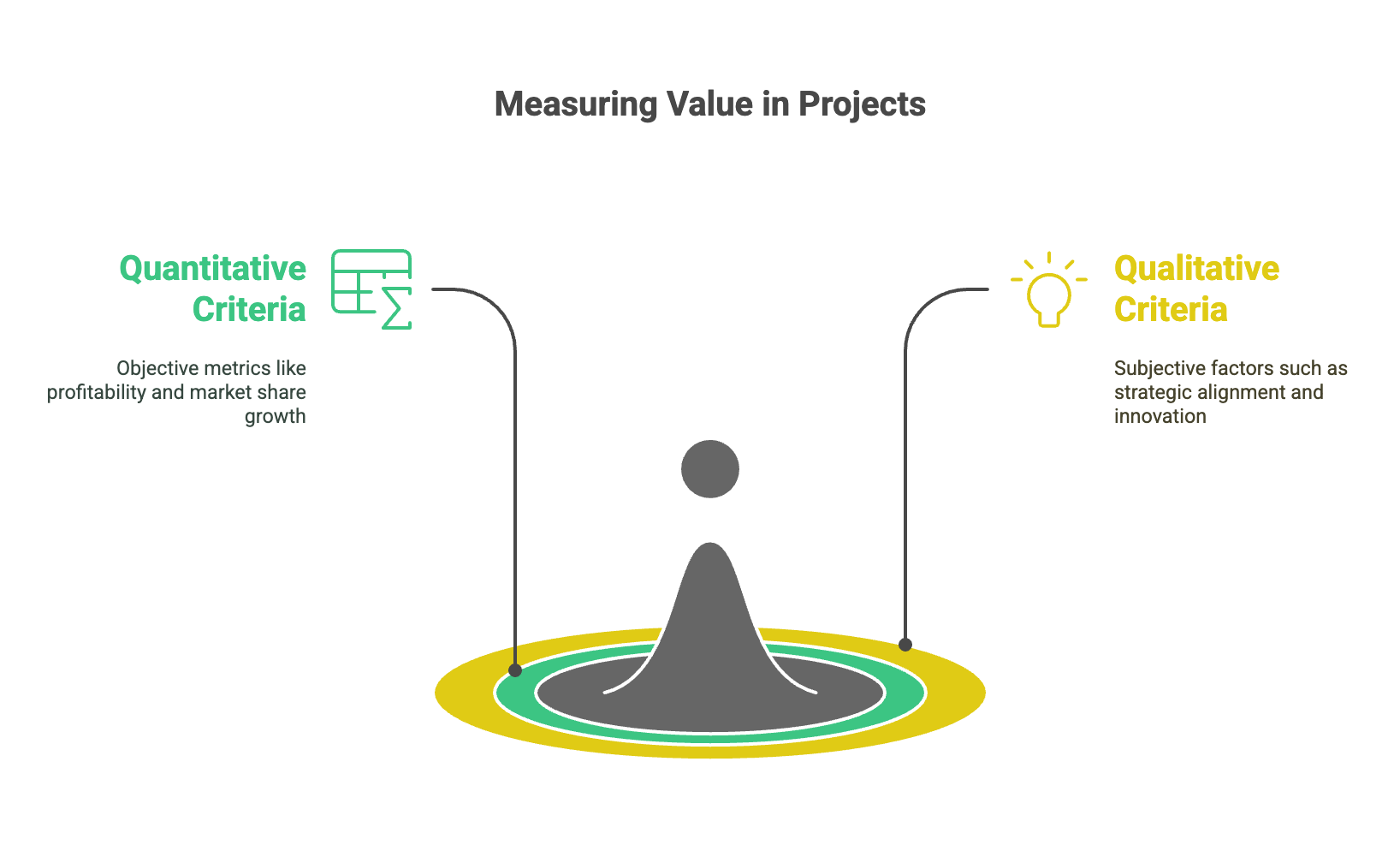
Project Selection Methods
Economic Methods
Economic approaches quantify the financial returns or costs associated with each project. Popular tools include:
- Net Present Value (NPV): Calculates the difference between the present value of cash inflows and outflows over a project's lifecycle.
- Internal Rate of Return (IRR): Estimates the profitability of investments.
- Payback Period: Assesses the time required for a project to recoup its initial investment.
These methods provide clarity on the financial implications of projects, making them a staple for capital-intensive industries.
Scoring Methods
Scoring models assign weights and scores to pre-defined criteria, allowing for customized prioritization. Normally:
- Organizations identify relevant factors (e.g., cost, strategic alignment, feasibility).
- Each criterion is assigned a weight based on its importance.
- Projects are scored against these criteria, with total scores guiding the selection process.
This tailored approach is particularly useful for aligning decisions with an organization’s unique goals.
Voting Methods
Voting models rely on the expertise and judgment of a cross-section of stakeholders. These models emphasize inclusivity and collaboration, leveraging diverse perspectives to prioritize initiatives. Stakeholders might use techniques like dot voting, weighted voting, or Pairwise Ranking to reach consensus.
Voting is particularly valuable when consensus and organizational buy-in are as important as the final decision.
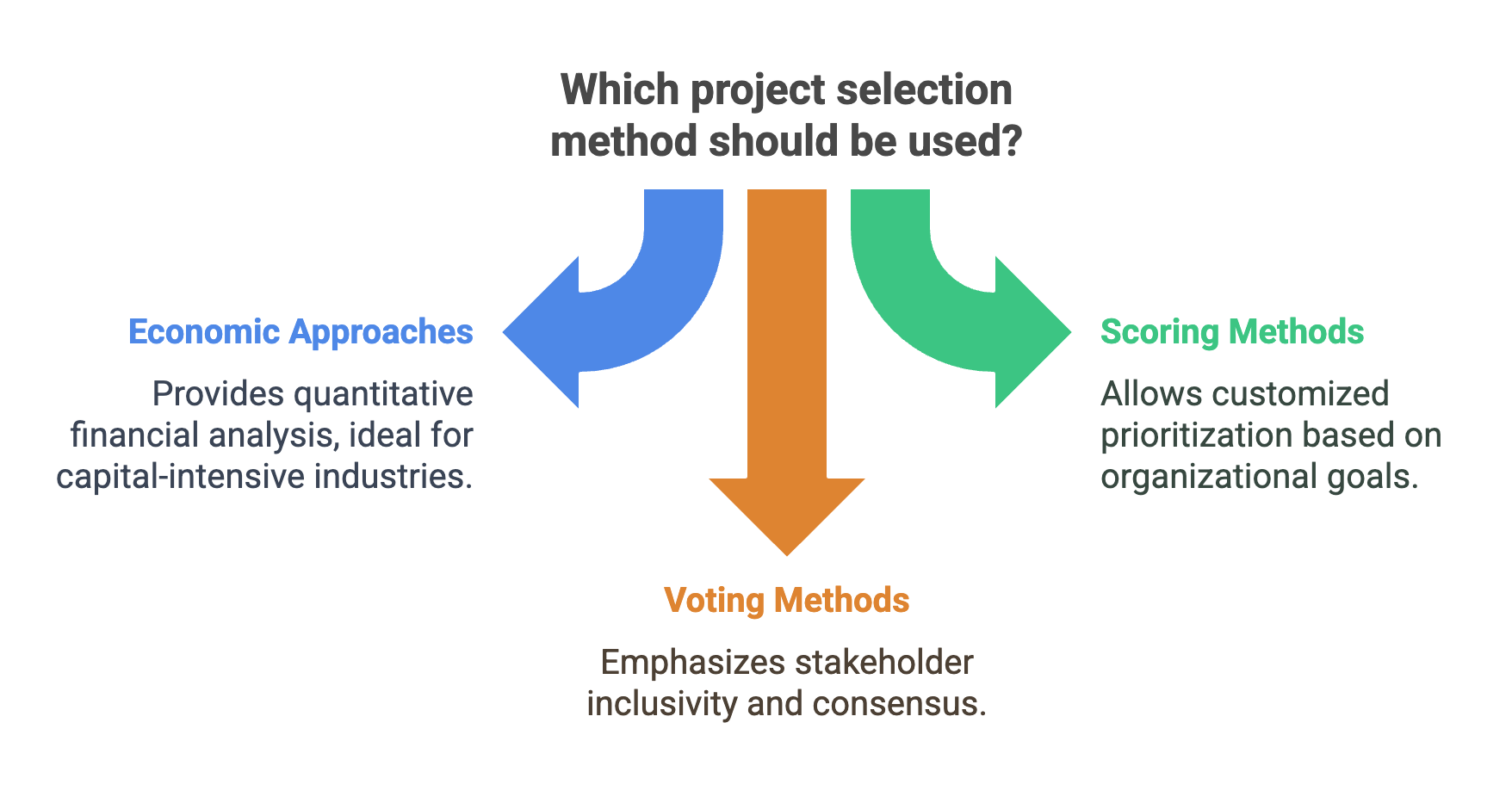
Pairwise Ranking in Detail
What is Pairwise Ranking?
Pairwise Ranking is a decision-making tool designed to rank projects by comparing them two at a time. This approach is especially effective when dealing with a manageable number of initiatives. The goal is to determine which projects provide the most value relative to each other based on agreed-upon criteria.
How to Use Pairwise Ranking to Select Projects?
To facilitate understanding of the Pairwise Ranking tool, we will use the example provided by Russ J. Martinelli and Dragan Z. Milosevic in *Project Management Toolbox*. In this example, six projects are compared using a step-by-step method for setting priorities. Follow these three steps to apply Pairwise effectively:
Step 1 - Identify and Document Criteria: Choose 3–5 criteria to evaluate your initiatives. These criteria can be either qualitative (e.g., strategic alignment, customer satisfaction) or quantitative (e.g., return on investment, revenue potential). Ensuring consistency is essential, so document the criteria clearly for all evaluators.
To illustrate, here is a list of possible criteria:
Criteria | Type | Description |
Strategic Alignment | Qualitative | How well does the initiative align with organizational goals? |
Customer Satisfaction | Qualitative | Will this project improve the customer experience? |
Innovation | Qualitative | Does the project introduce new capabilities or improvements? |
Usability | Qualitative | How user-friendly or accessible is the project outcome? |
Sustainability Impact | Qualitative | Does the initiative contribute to sustainability goals? |
Return on Investment (ROI) | Quantitative | What is the expected ROI for the project? |
Revenue Potential | Quantitative | How much revenue could this project generate? |
Cost-Benefit Ratio | Quantitative | Is the cost justified by the projected benefits? |
Time to Market | Quantitative | How quickly can this project be completed? |
Risk Level | Quantitative | What is the project's risk score based on probability and impact? |
Once these criteria are selected, they serve as the foundation for a structured comparison of projects, providing clarity and consistency in the evaluation process.
Step 2 - Create the Comparison Matrix: A square matrix is constructed, listing the projects in ascending order on both vertical and horizontal axes. This ensures that each project is compared with every other project only once, avoiding redundancies. The numbering in the matrix should be consistent, organizing each project to allow structured cross-comparisons.
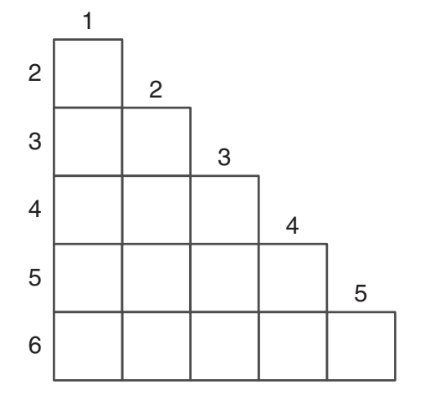
Step 3 - Compare Projects Pair by Pair: For each project pair, stakeholders assess which of the two best meets the selected criteria. For example, when comparing Project 1 with Project 3, stakeholders determine which project performs better based on criteria like Return on Investment (ROI), strategic alignment, or any other predetermined criteria. The preference is recorded in the matrix by entering the number of the preferred project in the corresponding cell.
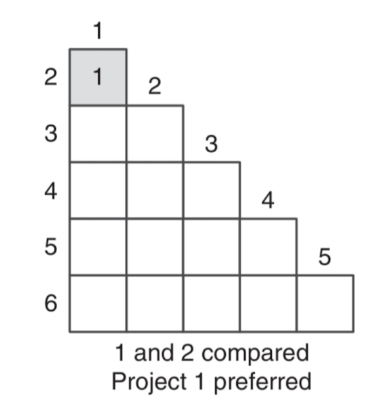
Step 4 - Complete the Comparison Matrix: This comparison process continues until the matrix is fully populated, as demonstrated in the example. Martinelli and Milosevic illustrate this step by showing that, in each pairwise comparison, the number of the preferred project is entered in the respective position. For instance, if Project 6 is preferred over Project 5 in a comparison, the number "6" is placed in that specific cell.
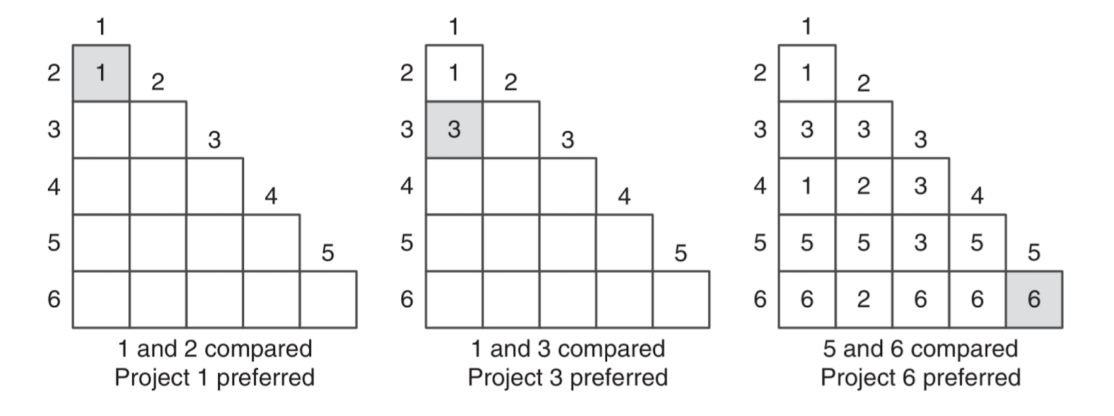
Step 5 - Tally the Comparison Results: Once the matrix is complete, tally the number of times each project was preferred in the comparisons. In this example, the authors use a scoring table to record how many times each project was chosen, helping to calculate the total preferences for each project.
Candidate Projects | 1 | 2 | 3 | 4 | 5 | 6 |
Times prefered | 2 | 2 | 4 | 0 | 3 | 4 |
Step 6 - Rank the Projects: Based on the tally results, the projects are ranked according to the number of times they were preferred. In case of a tie between two projects (as occurs in the example between Projects 3 and 6), the matrix is consulted again to check which project was preferred in the direct comparison between the two, thereby assigning the final ranking.
Candidate Projects | 1 | 2 | 3 | 4 | 5 | 6 |
Times prefered | 2 | 2 | 4 | 0 | 3 | 4 |
Project Ranking | 4 | 5 | 2 | 6 | 3 | 1 |
This example by Martinelli and Milosevic demonstrates how the pairwise ranking method simplifies project prioritization by reducing evaluation to direct comparisons between pairs. This approach facilitates a structured process that provides transparency in the results and allows stakeholders to visualize project priority effectively.
Just to mention a real use case of this tool, in 2016, Malaysia’s government applied Pairwise Ranking to evaluate and prioritize renewable energy projects (read more). This method helped rank various energy alternatives—such as solar, biomass, and hydro—according to environmental, economic, and social criteria. By comparing each option in pairs, decision-makers developed a consensus ranking for optimal choices, reflecting expert input and resource constraints. The approach was instrumental in shaping a national strategy for sustainable energy development, supporting well-aligned policy decisions based on ranked preferences from multiple experts and stakeholders.
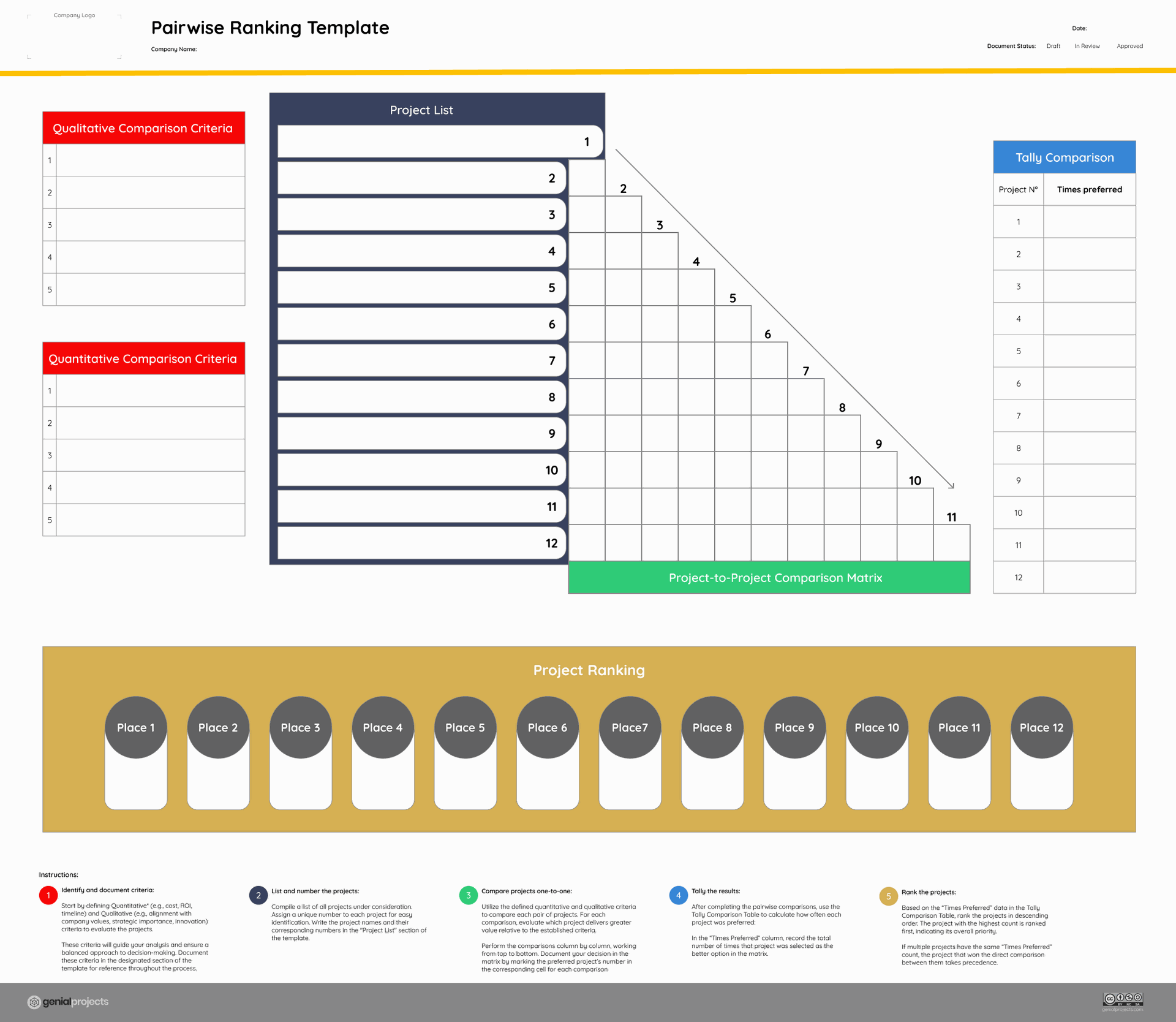
Free Pairwise Ranking Template available on our website.
Start identifying and prioritizing the right initiatives with confidence. Don’t just guess—decide strategically!
Benefits of Using Pairwise Ranking
There are several benefits to using Pairwise Ranking over other project selection approaches. Perhaps the most notable is that it combines the strengths of other project selection tools, allowing decision-makers to select both quantitative and qualitative criteria that are most relevant to the decision at hand. It also offers them the opportunity to easily compare projects and vote for those that best meet the chosen criteria. In this way, Pairwise Ranking can be considered a tool that simplifies complexity, promotes collaboration, builds consensus, and enhances objectivity in project selection.
Key Takeaways
Project selection is a critical step in ensuring project success, requiring a balanced approach that combines both quantitative and qualitative analysis. A structured process allows for a comprehensive evaluation, minimizing biases and enhancing decision-making.
Various methods, including economic models, scoring systems, and voting techniques, provide a versatile toolkit that can be applied to different project scenarios. These approaches allow for flexibility, enabling leaders to assess projects from multiple perspectives and select the most impactful initiatives.
The pairwise ranking technique, in particular, stands out for its ability to foster collaboration, simplify decision-making, and build alignment among stakeholders. By engaging everyone in the decision process, this method ensures a consensus-driven selection that reflects collective priorities.
By implementing these methodologies, leaders are empowered to make informed decisions that maximize resource allocation, optimize project outcomes, and drive strategic success across their organizations.